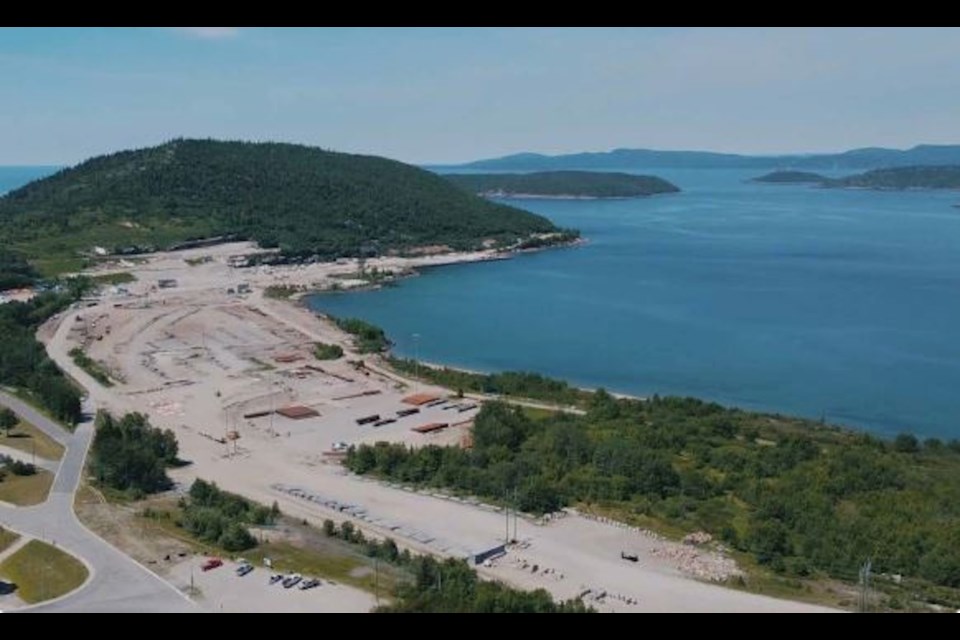Marathon is reclaiming its waterfront.
Generations ago, the sights, sounds and smells of most working harbours were not the kind of places that attracted strollers and tourists.
Marathon’s history was no different. Industrialization pushed the original town centre inland, away from the natural harbour on the north shore of Lake Superior and the landscape that provided inspiration for the Group of Seven artists in the 1920s.
The demise of Marathon Pulp in 2009, the subsequent demolition of the mill buildings, and the environmental cleanup of Peninsula Harbour has cast the waterfront in a new light, with new possibilities.
The community of 3,100 is rolling out plans to revive its waterfront lands with a mixed-use industrial and recreational development that will restore its former commercial harbour and bring residents back to the water’s edge.
With 99 acres to play with and a 500-foot (152-metre) wharf left over from the pulp mill days, town CAO Darryl Skworchinski and Marathon’s hired landscape architects and consultants want to “activate the waterfront” and use it as a “local economic development driver.”
“That’s why we were so ardent after the bankruptcy of the mill in 2009 to make sure it was torn down, cleaned up and returned to a brownfield site, and was reusable,” Skworchinski said.
“We stayed on that file for 10 years from a legal perspective to make sure that happened (in order) to take it over.”
Want to read more stories about business in the North? Subscribe to our newsletter.
The arrival of Generation Mining in 2019 has changed things. The company aims to put its palladium and copper deposit, north of town, into production by 2025.
It figures prominently in Marathon’s strategy for a new community centre, the port and other projects in the works.
With 400 mining jobs in the offing, Marathon officials want to upgrade the local amenities to attract as many working families as possible to town.
The mining company hasn’t officially given the green light to begin construction but preparatory work at the site begins early in the new year.
“We do want to capitalize on the Generation project, if it’s approved,” said Skworchinski. “We don’t expect everyone’s going to live in Marathon but if the (mining) workforce is 400 if it would be great to capture half or three-quarters of that.
“To do that we want a community that’s attractive and very active.”
Skworchinski said the municipality has strived to be a family-friendly community with deliberate and strategic investments in new fibreoptics, health care and expanded marina facilities.
There are other projects in the go for a natural gas distribution network, plans to make its scenic Pebble Beach area a tourism lookout, and an upcoming tendering process that will dust off dormant plans for a 120-lot subdivision dating back to the early Hemlo mining days.
“It fits well with the vision we created eight years ago with council. Over the next four to six years, it’s going to come full circle and ultimately help drive the growth here locally,” said Skworchinski.
At Peninsula Harbour, they hope to take a page from waterfront revitalization projects in Thunder Bay and Duluth with a mix of industrial, commercial and recreational uses.
Establishing a commercial port is no easy feat, so the town hired QSL (formerly Quebec Stevedoring) in September to help navigate those waters in setting up a port governance model, a financial structure, to decide on what port infrastructure will be necessary, and to help recruit a full-time port CEO and support staff over the next six to 12 months.
It’s shaping up to be the only port on the Canadian side of Lake Superior between Sault Ste. Marie and Thunder Bay. Skworchinski thinks this midway point on the north shore definitely works in their favour.
Sign up for the Sudbury Mining Solutions weekly newsletter here.
In promoting such a facility as a regional port, there are cargo opportunities to cater to the forestry and mining industries, and in receiving road salt cargoes, shipped in from Goderich.
There will be more definitive ideas when QSL delivers a market opportunities study in January. Once a port CEO is in place, that person will be responsible for tracking down leads and drumming up business.
“I think it’s a blank slate right now and lots of opportunity for us,” said Skworchinski.
Though the port authority is only in its nascent stages, he said they’ve already fielded some phone inquiries from Ontario companies interested in moving cargo through Marathon.
“I think it’s only going to pick up steam,” he said.
Close by, the town is proposing an Active Living Centre. It calls for an 1,100-seat arena, two pools, indoor running track and gym, and some multi-use rooms. Other naturally vegetated areas, which were never used for mill activity, could host ball fields, tennis courts, a dog park, a beach, and hiking trails.
The centre was originally slated for an empty eight-acre lot at a former elementary school site. But the situation changed when Valard, the general contractor for the East-West Tie transmission line, wanted the fully serviced site for a construction camp.
When that project wrapped up, Generation Mining came calling, looking for a similar arrangement for a construction camp. Too lucrative from a leasing standpoint for the town to dismiss, the town’s attention turned to the waterfront.
Their landscape architects are sketching out the Active Living concept as a themed community hub, recreational and lifestyle gathering place that reconnects the town with the waterfront, the boreal forest and the Canadian Shield, while highlighting the town’s industrial past and the history of the area’s Indigenous people.
“The most simplistic answer I can give in terms of a model is what they’ve done in Duluth at Canal Park,” said Skworchinski.
“It won’t be that big but our architects and engineers are confident it can all work in that space. It’s gonna be exciting to put it together in 2023.”




